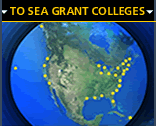By
Sami J. Grimes
Data, numbers, biology, Latin—the deep blue unknown
world—to many, marine science seems difficult to understand.
Yet, most of us drink water, eat fish and vacation at beaches.
How can this gap be bridged? COSEE may be the answer.
COSEE
stands
for
Centers
for
Ocean
Sciences
Education
Excellence
and
refers
to
centers
around
the
country
in
which
scientists
who
explore
the
ocean
world
can
work
collaboratively
with
educators
who
will
bring
these
discoveries
to
the
classroom.
In conjunction
with the National
Science Foundation,
Sea Grant has
assisted in developing
five of the seven
COSEE centers
across the nation.
Broadly, the
COSEE network
aims to facilitate
the integration
of research into
high-quality
educational activities,
programs and
materials in
order to engage
students and
their teachers,
and develop their
interest into
a mature understanding
of the relevance
of the oceans
to their lives.
These centers
are quite literally
where educators
meet scientists
face to face
in order to increase
and enhance collaboration
and communication.
“ COSEE is paradigm
shift: it’s changing
the way things have been.
Traditionally, scientists
have come up with answers
that eventually end up
in a textbook ten years
later. Now, we can actually
bring scientists and
educators together in
a way that benefits both
professionally,” said
Elizabeth Day, Program
Director of Education
at NOAA’s National
Sea Grant Office. Day
was part of the initial
COSEE conversation in
mid-1999 at the National
Science Foundation (NSF)
and has been integral
in involving the Sea
Grant network with COSEE.
The
Inception
From the initial
COSEE discussion
in 1999, the
NSF’s Division
of Ocean Sciences
(OCE) created
an internal white
paper that expressed
the need for
a coordinated
national effort
to “make
the best use
of available
resources for
ocean education.” The
paper also addressed
the number of
missed opportunities
to “use
the exciting
discoveries of
oceanographic
research to catch
the imagination
of young minds
and involve them
in a lifetime
of science learning.”
In a collaboration
of efforts among
many in the marine
science education
community, white
papers, proposals
and conversations
gave rise to
the first COSEE
workshop, which
took place May
2000. The goal
of the workshop
was “to
create a document
that recommends
strategies for
the National
Science Foundation
and other Federal
agencies to use
in a nationally
coordinated effort
to improve and
promote ocean
sciences education
in response to
the opportunities
identified by
this workshop.” The
main objective
that came from
the workshop
was that COSEE
needed to be
a network; there
needed to be
more than one
center in order
for the initiative
to work.
By November 2001,
NSF issued requests
for proposals
to those interested
in managing COSEE
centers. In January
2002, twenty-seven
proposals were
submitted with
twenty-four Sea
Grant Programs
involved. NSF
announced that
there would be
seven COSEE centers,
along with one
COSEE central
coordinating
office in July
2002. Five of
the seven funded
regional sites
include Sea Grant
partners. They
are: the New
England Region
COSEE (WHOI Sea
Grant), California
COSEE (California
Sea Grant), COSEE-West
(USC Sea Grant),
the Central Gulf
of Mexico COSEE
(Mississippi/Alabama
Sea Grant and
Florida Sea Grant),
and the Southeast
COSEE (South
Carolina Sea
Grant Consortium,
North Carolina
Sea Grant and
Georgia Sea Grant).
Virginia Sea
Grant, along
with the National
Sea Grant Office,
also work closely
with CORE, which
houses the central
coordinating
office, to help
administer the
program and host
both the COSEE
web site (www.cosee.org) and
the award-winning
Bridge web site (www.marine-ed.org).
Making
a Difference
Although COSEE
is at its very
beginning, the
centers do seem
to be bridging
the gap. “It’s
important that
the teachers
have a good understanding
of the science
in order to be
able to teach
it,” said
Phyllis Grifman,
the associate
director of the
USC Sea Grant
Program. “Our
experience has
been that the
teachers really
like it when
they can talk
directly to the
scientists. It
allows them to
go into the classroom
with a degree
of knowledge
and enthusiasm
that is then
passed on to
the kids.”
Not only does
Sea Grant provide
learning tools,
but through COSEE,
Sea Grant aims
to allow educators
and students
to have hands-on
experience and
interaction with
scientists so
that others may
begin to understand
the deep blue
unknown world.
The first COSEE
network meeting
in Washington,
D.C. was held
March 3-4, 2003.
Each COSEE center
leader discussed
goals and current
projects. To
see each presentation,
visit www.cosee.org.
Top | Story Archive
|





